
Apollo 11 was the American spaceflight that first landed humans on the Moon. Commander Neil Armstrong and Lunar Module Pilot Buzz Aldrin landed the Apollo Lunar Module Eagle on July 20, 1969, at 20:17 UTC, and Armstrong became the first person to step onto the Moon's surface six hours and 39 minutes later, on July 21 at 02:56 UTC. Aldrin joined him 19 minutes later, and they spent about two and a quarter hours together exploring the site they had named Tranquility Base upon landing. Armstrong and Aldrin collected 47.5 pounds (21.5 kg) of lunar material to bring back to Earth as pilot Michael Collins flew the Command Module Columbia in lunar orbit, and were on the Moon's surface for 21 hours, 36 minutes before lifting off to rejoin Columbia.

The Apollo program, also known as Project Apollo, was the United States human spaceflight program carried out by the National Aeronautics and Space Administration (NASA), which succeeded in preparing and landing the first humans on the Moon from 1968 to 1972. It was first conceived in 1960 during President Dwight D. Eisenhower's administration as a three-person spacecraft to follow the one-person Project Mercury, which put the first Americans in space. Apollo was later dedicated to President John F. Kennedy's national goal for the 1960s of "landing a man on the Moon and returning him safely to the Earth" in an address to Congress on May 25, 1961. It was the third US human spaceflight program to fly, preceded by the two-person Project Gemini conceived in 1961 to extend spaceflight capability in support of Apollo.

Neil Alden Armstrong was an American astronaut and aeronautical engineer who in 1969 became the first person to walk on the Moon. He was also a naval aviator, test pilot, and university professor.
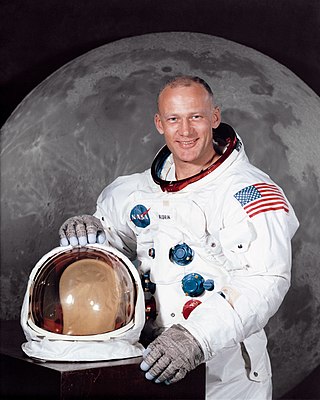
Buzz Aldrin is an American former astronaut, engineer and fighter pilot. He made three spacewalks as pilot of the 1966 Gemini 12 mission. He was the Lunar Module Eagle pilot on the 1969 Apollo 11 mission and became the second person to walk on the Moon after mission commander Neil Armstrong.

Michael Collins was an American astronaut who flew the Apollo 11 command module Columbia around the Moon in 1969 while his crewmates, Neil Armstrong and Buzz Aldrin, made the first crewed landing on the surface. He was also a test pilot and major general in the U.S. Air Force Reserve.

Eugene Andrew Cernan was an American astronaut, naval aviator, electrical engineer, aeronautical engineer, and fighter pilot. During the Apollo 17 mission, Cernan became the eleventh human being to walk on the Moon. As he re-entered the Apollo Lunar Module after Harrison Schmitt on their third and final lunar excursion, he remains the most recent person to walk on the Moon.

David Randolph Scott is an American retired test pilot and NASA astronaut who was the seventh person to walk on the Moon. Selected as part of the third group of astronauts in 1963, Scott flew to space three times and commanded Apollo 15, the fourth lunar landing; he is one of four surviving Moon walkers and the only living commander of a spacecraft that landed on the Moon.
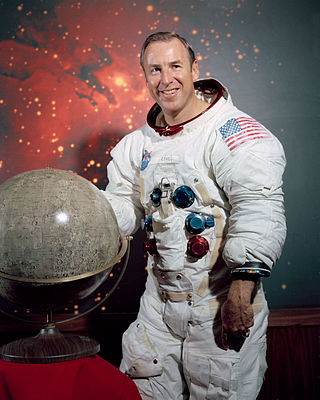
James Arthur Lovell Jr. is an American retired astronaut, naval aviator, test pilot and mechanical engineer. In 1968, as command module pilot of Apollo 8, he became, with Frank Borman and William Anders, one of the first three astronauts to fly to and orbit the Moon. He then commanded the Apollo 13 lunar mission in 1970 which, after a critical failure en route, circled the Moon and returned safely to Earth.

Project Gemini was the second United States human spaceflight program to fly. Conducted after the first, Project Mercury, and while the Apollo program was still in development, Gemini was conceived in 1961 and concluded in 1966. The Gemini spacecraft carried a two-astronaut crew. Ten Gemini crews and 16 individual astronauts flew low Earth orbit (LEO) missions during 1965 and 1966.

NASA Astronaut Group 2, also known as the Next Nine and the New Nine, was the second group of astronauts selected by the National Aeronautics and Space Administration (NASA). Their selection was announced on September 17, 1962. The group augmented the Mercury Seven. President John F. Kennedy had announced Project Apollo, on May 25, 1961, with the ambitious goal of putting a man on the Moon by the end of the decade, and more astronauts were required to fly the two-man Gemini spacecraft and three-man Apollo spacecraft then under development. The Mercury Seven had been selected to accomplish the simpler task of orbital flight, but the new challenges of space rendezvous and lunar landing led to the selection of candidates with advanced engineering degrees as well as test pilot experience.

NASA Astronaut Group 3—'The Fourteen'—was a group of fourteen astronauts selected by NASA for the Gemini and Apollo program. Their selection was announced in October 1963. Seven were from the United States Air Force, four from the United States Navy, one was from the United States Marine Corps and two were civilians. Four died in training accidents before they could fly in space. All of the surviving ten flew Apollo missions; five also flew Gemini missions. Buzz Aldrin, Alan Bean, Gene Cernan and David Scott walked on the Moon.
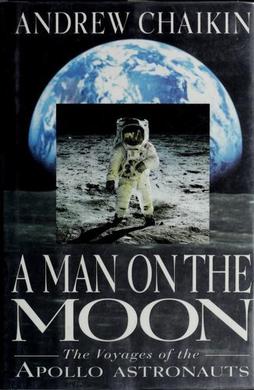
A Man on the Moon: The Voyages of the Apollo Astronauts is a 1994 book by Andrew Chaikin. It describes the 1968-1972 voyages of the Apollo program astronauts in detail, from Apollo 8 to 17.

First Man: The Life of Neil A. Armstrong is the official biography of Neil Armstrong, the astronaut who became the first human to walk on the Moon, on July 20, 1969. The book was written by James R. Hansen and was first published in 2005 by Simon & Schuster. The book describes Armstrong's involvement in the United States space program, and details his personal life and upbringing.
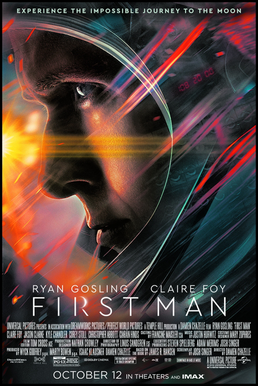
First Man is a 2018 American biographical drama film directed by Damien Chazelle from a screenplay by Josh Singer, based on the 2005 book of the same name by James R. Hansen. The film stars Ryan Gosling as Neil Armstrong, alongside Claire Foy, Jason Clarke, Kyle Chandler, Corey Stoll, Christopher Abbott, and Ciarán Hinds, and follows the years leading up to the Apollo 11 mission to the Moon in 1969.

John Hirasaki is an American mechanical engineer who worked for the United States' National Aeronautics and Space Administration (NASA) during the Apollo 11 mission, the first crewed mission to the Moon. In 1969 he – along with Buzz Aldrin, Neil Armstrong, Michael Collins, and William Carpentier – became one of the first five known humans to view lunar rocks inside Earth's atmosphere.

Command module Columbia (CM-107) is the spacecraft that served as the command module during Apollo 11, which was the first mission to land humans on the Moon. Columbia is the only spacecraft of the 1969 Apollo 11 mission that returned to Earth.
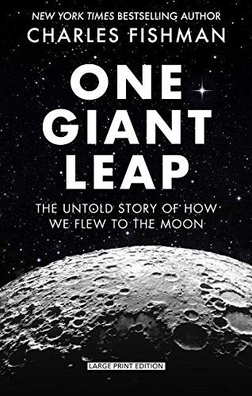
One Giant Leap: The Impossible Mission That Flew Us to the Moon is a 2019 nonfiction book by journalist Charles Fishman, about the Apollo program, that focuses on thousands of people who worked on it.

















